We had a windy time of it getting here, but we're now at Mackinac Island, a few miles east of the Mackinac 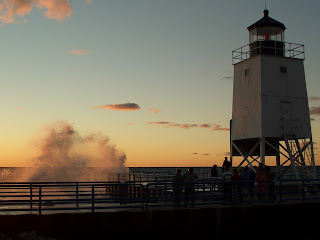 Bridge, longest in the Western Hemisphere. We had a 62-mile ride going NNE along the Lk. Michigan shore, facing a 15-25 mph NW wind. Fortunately a lot of the small roads we took had trees and/or bluffs to the west of the road, giving us some shelter, but it was a HARD day. The wind provided some dramatic waves in Charlevoix, our destination, as the photo shows. The town looks like it was the model for Lionel's little plastic
Bridge, longest in the Western Hemisphere. We had a 62-mile ride going NNE along the Lk. Michigan shore, facing a 15-25 mph NW wind. Fortunately a lot of the small roads we took had trees and/or bluffs to the west of the road, giving us some shelter, but it was a HARD day. The wind provided some dramatic waves in Charlevoix, our destination, as the photo shows. The town looks like it was the model for Lionel's little plastic 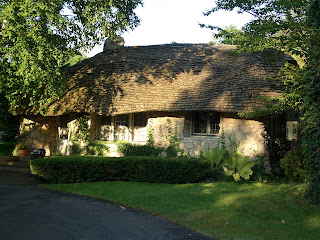 town parts, quaint houses, Victorian store fronts and all. A local architect built a number of stone houses that folks come to see (from the outside -- they're all private homes), and we had a nice walk past quite a few of them. The one pictured here is probably the cutest one we saw, and is known locally as "The Mushroom House" for its shape.
town parts, quaint houses, Victorian store fronts and all. A local architect built a number of stone houses that folks come to see (from the outside -- they're all private homes), and we had a nice walk past quite a few of them. The one pictured here is probably the cutest one we saw, and is known locally as "The Mushroom House" for its shape.
Our next day was short and easy and almost all on a bike trail through Petoskey, which has an even larger, quainter business district, one that has survived the building of a Walmart on the outskirts of town. Third and last day northward to Mackinac was on a road called the "Tunnel of Trees," and that it was. It was a fairly narrow road for a state highway, with trees growing right 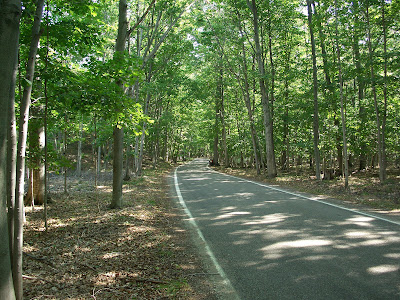 up to the shoulderless asphalt, but the traffic was almost non-existent except for motorcycle clubs out for their Sunday rides, and bicyclists. Lunch was at Legs Inn, founded a century ago by a Polish immigrant who liked the area and the people of the Ottowa tribe nearby. We had a great Polish lunch with sausage on rye bread, stuffed cabbage, pierogies and dumplings. Polish students work in the summer, augmenting the locals who keep it running through the winter. We could see four lighthouses from our table on the veranda, one reportedly in bad shape as it was used for target practice by Army bombers training for combat in WW II.
up to the shoulderless asphalt, but the traffic was almost non-existent except for motorcycle clubs out for their Sunday rides, and bicyclists. Lunch was at Legs Inn, founded a century ago by a Polish immigrant who liked the area and the people of the Ottowa tribe nearby. We had a great Polish lunch with sausage on rye bread, stuffed cabbage, pierogies and dumplings. Polish students work in the summer, augmenting the locals who keep it running through the winter. We could see four lighthouses from our table on the veranda, one reportedly in bad shape as it was used for target practice by Army bombers training for combat in WW II.
Mackinac Island has been a dream destination for us for decades. NO CARS!!! Just bikers, hikers, and LOTS of horses -- about 600 in summer. At night from our B&B we hear hoof beats
The island has a state highway all along the shore, exactly 8 miles long and totally level. For 6 of those
The town clusters around ferry docks for three boat lines that charge identical fares and have virtually identical schedules, all running boats every 30 minutes from 7 am 'til early evening. One street is fudge shop, restaurant, fudge shop, gift shop, fudge shop, old wood hotel, restaurant, fudge shop, book store, fudge shop . . . for about four blocks. Did we mention the Island is famous for fudge? We got a free sample in one from a student from Poland, who was very surprised to hear about Legs Inn, and positively salivating when we described our lunch there. Besides Poles, we've encountered quite a number of Jamaicans working summer jobs here and elsewhere in this part of Michigan, and were told there are also quite a few Filipinos and Chileans in the summer work force. Wonder how the Michigan congressional delegation voted on immigration reform this past year . . . This community would come to a grinding halt without 'guest workers,' it's pretty clear.
The island has a LOT of hotels and B&Bs, none more famous than the Grand Hotel, 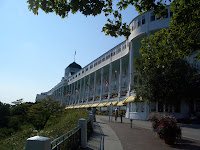 which was used with other island landmarks in the film "Somewhere In Time." There are many reminders on the
which was used with other island landmarks in the film "Somewhere In Time." There are many reminders on the  island about the movie. The hotel is enormous, as the "world's largest summer hotel" darned well ought to be, and a walk down the "world's largest front porch" takes a while, as you can see!
island about the movie. The hotel is enormous, as the "world's largest summer hotel" darned well ought to be, and a walk down the "world's largest front porch" takes a while, as you can see!
We've also enjoyed hiking around the island looking at the many stunning summer "cottages" built 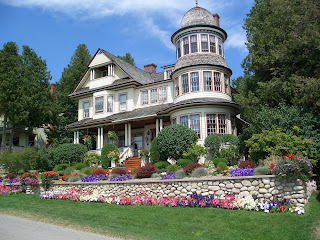 by wealthy Midwesterners in the 19th century, competing in size and architectural quaintness and almost all set off by colorful gardens. There is also a genuine fort on the island that was successfully attacked once with no loss of life. The commander learned of the declaration of the War of 1812 from his British opponent with a much larger force, and chose not to commit himself and his fort to martydom. Smart move, as the diplomats awarded Michigan, and thus the fort, back to the Americans 2 years later.
by wealthy Midwesterners in the 19th century, competing in size and architectural quaintness and almost all set off by colorful gardens. There is also a genuine fort on the island that was successfully attacked once with no loss of life. The commander learned of the declaration of the War of 1812 from his British opponent with a much larger force, and chose not to commit himself and his fort to martydom. Smart move, as the diplomats awarded Michigan, and thus the fort, back to the Americans 2 years later.
The weather has been dry except for light rain one morning a week ago. 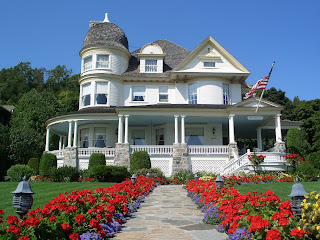 The wind has been strong while we've been on the island, and from the direction we're headed tomorrow. It's supposed to get lighter in speed, but not change direction. Could be another tough 65-miler when we leave. Temperature has been Fall-like, given the wind plus high temperatures only around 70. It could be worse. It gets cold enough here that in some winters (2 out of the past 4, from someone who's spent 4 winters here) Lake Huron freezes from St. Ignace, five miles away, all the way out to Mackinac Island, and locals mark an "ice bridge" with discarded Christmas trees that people drive across by snowmobile. In the "old days," in fact, it was how the island was resupplied in winter.
The wind has been strong while we've been on the island, and from the direction we're headed tomorrow. It's supposed to get lighter in speed, but not change direction. Could be another tough 65-miler when we leave. Temperature has been Fall-like, given the wind plus high temperatures only around 70. It could be worse. It gets cold enough here that in some winters (2 out of the past 4, from someone who's spent 4 winters here) Lake Huron freezes from St. Ignace, five miles away, all the way out to Mackinac Island, and locals mark an "ice bridge" with discarded Christmas trees that people drive across by snowmobile. In the "old days," in fact, it was how the island was resupplied in winter.
For those of you trying to keep track of our route, we'll see if we can put up a map next time be blog on. Having come up the west side of Michigan's lower peninsula and jumped to this island between the upper and lower peninsulas, we're now about to ride down the east side of the state, along Lake Huron. In one week we'll enter Ontario from Marine City MI, along the St. Clair River that separates Michigan from Ontario, US from Canada. We expect to see a lot more lakeshore, the world's largest open-pit limestone mine, and a town with a German heritage that appears to be something like Leavenworth WA, except that it really IS German. But also, now, perhaps a bit hokey. We'll let you all know.
We've gotten a few Comments via this blog site from folks we've met along the way and told about our blog. Keep the comments coming! We enjoy hearing that folks are reading about our trip.
Cheers, Louise and Jeff

 We expect to say much more about Beam and his delightful sister Hanachan when we arrive in Ithaca in September, and begin a four month stay there to help out with the babysitting and to join many other members of the family in getting to know Cornell. For now, all we have is photos and reports that all are doing well.
We expect to say much more about Beam and his delightful sister Hanachan when we arrive in Ithaca in September, and begin a four month stay there to help out with the babysitting and to join many other members of the family in getting to know Cornell. For now, all we have is photos and reports that all are doing well.